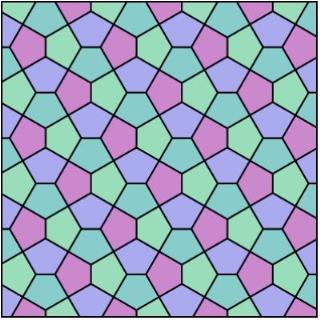New pentagonal form of carbon could outperform graphene
5 February 2015
A new structural variant of carbon called penta-graphene is a semiconductor and has physical properties that could outperform graphene, according to researchers from the US, China and Japan.
The newly discovered material is a single layer of carbon pentagons and appears to be dynamically, thermally and mechanically stable. Most forms of carbon are made of atoms arranged in a hexagonal pattern, sometimes interspersed with pentagons.
The researchers simulated the synthesis of penta-graphene using computer modelling. The results suggest that the material would possess very high strength and be capable of withstanding temperatures of up to 1,000 degrees Kelvin.
The investigation was inspired by a pentagonal pattern of tiles on the streets of Cairo. Dr Qian Wang, a professor at Peking University and an adjunct professor at Virginia Commonwealth University (VCU), was dining in a restaurant in Beijing when she noticed artwork on the wall depicting pentagonal tiles from the streets of Cairo.
"I took a picture and sent it to one of my students, and said, 'I think we can make this. It might be stable. But you must check it carefully.' He did, and it turned out that this structure is so beautiful yet also very simple," said Wang.

An example of Cairo tiling. Source: Wikimedia Commons
Puru Jena, PhD, distinguished professor in the Department of Physics in VCU's College of Humanities and Sciences and the paper's senior author, said, "The three last important forms of carbon that have been discovered were fullerene, the nanotube and graphene. Each one of them has unique structure. Penta-graphene will belong in that category. You know the saying, diamonds are forever? That's because it takes a lot of energy to convert diamond back into graphite. This will be similar."
"When you take graphene and roll it up, you make what is called a carbon nanotube which can be metallic or semiconducting. Penta-graphene, when you roll it up, will also make a nanotube, but it is always semiconducting," he added.
The way the material stretches is also highly unusual, the researchers said. "If you stretch graphene, it will expand along the direction it is stretched, but contract along the perpendicular direction," Wang said. "However, if you stretch penta-graphene, it will expand in both directions."
The material's mechanical strength, derived from a rare property known as Negative Poisson's Ratio, may hold especially interesting applications for technology, the researchers said. Penta-graphene's properties suggest that it may have applications in electronics, biomedicine, nanotechnology and more.
The next step, said Jena, is for scientists to synthesize penta-graphene. "Once you make it, it [will be] very stable. So the question becomes, how do you make it? In this paper, we have some ideas. Right now, the project is theoretical. It's based on computer modelling, but we believe in this prediction quite strongly. And once you make it, it will open up an entirely new branch of carbon science. Two-dimensional carbon made completely of pentagons has never been known."
Along with Jena and Wang, other researchers are from Peking University, the Chinese Academy of Science in Shanghai, and Tohoku University in Sendai, Japan.
Reference
Zhang S, et al. Penta-graphene: A new carbon allotrope. PNAS 2015 ; published ahead of print February 2, 2015, doi:10.1073/pnas.1416591112
Source: VCU